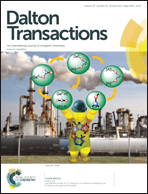Acetato-bridged dinuclear lanthanide complexes with single molecule magnet behaviour for the Dy2 species†
Abstract
Five dinuclear lanthanide complexes with formula [Ln2L2(OAc)4(MeOH)a(H2O)b]·cMeOH·dH2O (a = 2, b = 0, c = 2, d = 0, Ln = Sm (1), Gd (2), Dy (3); a = 0, b = 2, c = 4, d = 2, Ln = Tm (4)) and [Yb2L2(OAc)4(MeOH)2]·[Yb2L2(OAc)4(H2O)2]·2H2O (5) (HL = (E)-N′-(2-hydroxybenzylidene)-2-mercaptonicotinohydrazide), have been synthesized and their crystal structures and magnetic properties are reported. All five complexes are centrosymmetric, showing a similar dinuclear core with two lanthanide ions in each complex being bridged by acetate groups in the η1:η2:μ2 mode. The various coordination modes of acetate groups result in two kinds of coordination geometries for Ln ions with the ones in complexes 1–4 and the Yb2 in 5 being nine-coordinated with a mono-capped square antiprism geometry, while the Yb1 ions in the other part of complex 5 are eight-coordinated with a triangular dodecahedron geometry. Magnetic susceptibility studies reveal that complex 3 shows single molecule magnet behaviour with an energy barrier of 39.1 K. In addition, comparison of the structural parameters among the similar Dy2 SMMs with a η1:η2:μ2 coordination mode of carboxylate groups reveals the significant role played by coordination geometry in modulating the relaxation dynamics of SMMs.


 Please wait while we load your content...
Please wait while we load your content...